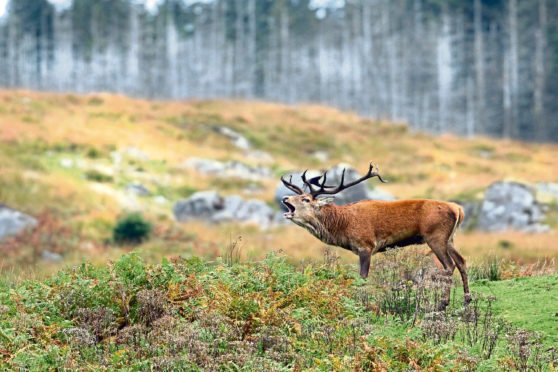Swirling rain swept across the flanks of this remote Deeside glen, and along the banks of a nearby gushing burn, newly arrived fieldfares cackled and bickered as they gorged upon the ripened scarlet clusters of rowan berries.
Then, the air was broken by a strange echoing noise; a deep roar in the distance that carried far into the wind. The more you listened the more the sound became apparent.
Fumbling for my binoculars, a quick scan of the far side of the glen revealed one of Scotland’s greatest natural spectacles – rutting red deer.
A proud stag with many prongs to his antlers bowed his head and let rip his deep-throated bellow. He then rushed towards another stag that was beginning to edge upon his small harem of hinds. The message was unequivocal – keep off, these females are mine!
It was a tiresome task, and as soon as the stag engaged with one male, then another would suddenly encroach into the other side of the harem, causing the stag to charge back again in anger and snort his defiance.
It was apparent that this Monarch of the Glen would only be able to cope with such pressure for so long and he will soon have to mate with the hinds to ensure that his genes are carried through to the next generation.
For a stag, the aim of the rut is simple, to try and mate with as many hinds as possible. To do so, the older more mature stags round up a harem of hinds, and the bigger and stronger he is the more he can get and protect for himself.
But it is impossible to keep an eye on all of them all of the time.
This has resulted in different mating strategies with some of the younger and less dominant males waiting for the opportunity to quickly rush in and mate with a hind when the attention of the harem master is otherwise diverted. One of my zoology lecturers at Aberdeen University dubbed these hit-and-run stags as ‘sneaky copulators’.
A successful stag may be able to protect a harem of up to 20 hinds, and because so much time and energy is spent on the rut, they are often lean and in poor condition towards the end.
Red deer management is a controversial and complex issue. Where the populations are too high, their presence can be damaging to the environment, most notably through the prevention of the natural regeneration of trees.
However, deer are a vital and iconic part of our landscape and deer carrion is an important source of food for a variety of upland wildlife, especially golden eagles.
Indeed, a red deer carcass has the potential to support a pair of eagles for a significant period in the depths of a Highland winter, especially in western areas, where other prey such as mountain hares are scarce.
Info
Red deer are common in the Highlands and now is the most dramatic time to see them! Rutting starts at the end of September and beginning of October and only lasts for a few weeks.
